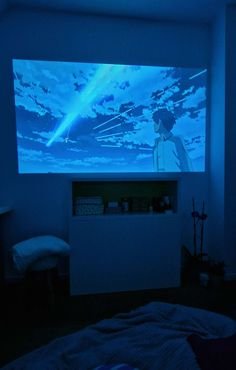XTEN-AV is committed to helping AV enthusiasts create personalized home theater experiences. One of the key elements of a successful bedroom projector setup is the projector screen. While commercial screens offer excellent quality, building a DIY projector screen can be a cost-effective and customizable solution. Creating your own screen allows you to tailor it to your bedroom size, aesthetics, and viewing preferences.
This guide will walk you through how to build a DIY projector screen for your bedroom, including material selection, measurements, construction tips, and installation advice. By the end, you will have the right projector screen for your bedroom that enhances your viewing experience while complementing your space.
1. Understanding the Basics of a Projector Screen
Before setting up a projector in your bedroom, it is important to understand what makes a good projector screen:
- Screen Material – Should be smooth, reflective, and capable of displaying bright, clear images. Common options include blackout cloth, canvas, or projector-specific fabrics.
- Screen Size – Should match the size of your bedroom and your projector’s throw distance. Oversized screens in small rooms can overwhelm the space, while too small screens reduce immersion.
- Screen Surface – Matte white surfaces are ideal for bedrooms with controlled lighting, while ambient light rejecting surfaces work in brighter rooms.
Understanding these basics helps you design a DIY projector screen that provides excellent image quality.
2. Measuring Your Bedroom for the Screen
Accurate measurements are crucial for your bedroom projector setup:
- Wall Space – Determine where the screen will be mounted. Make sure it is free from obstructions like windows, furniture, or light fixtures.
- Throw Distance – Measure the distance between the projector and the wall or screen location. This ensures the image fits the DIY screen perfectly.
- Screen Height – Ideally, the center of the screen should align with your eye level when seated or lying on the bed.
Taking precise measurements ensures your DIY projector screen integrates seamlessly with your bedroom layout.
3. Choosing Materials for a DIY Projector Screen
Selecting the right materials affects the quality and durability of your screen:
- Frame – Use lightweight materials like wood or PVC pipes to construct the frame. Ensure it is sturdy enough to hold the screen fabric taut.
- Screen Fabric – Options include blackout cloth, spandex, or high-quality canvas. Matte white is preferred for bedrooms to reduce glare.
- Fasteners – Staples, hooks, or clamps can be used to attach the fabric to the frame securely.
Choosing quality materials ensures a smooth, flat surface for your images and a durable screen that lasts for years.
4. Building the Frame
The frame forms the backbone of your DIY projector screen:
- Cut the frame material to match the dimensions of your screen.
- Assemble the frame using screws, brackets, or PVC connectors. Make sure it is square and stable.
- Sand the edges if using wood to prevent fabric damage and improve aesthetics.
A well-built frame ensures your screen remains flat and provides a professional look for your bedroom projector setup.
5. Attaching the Screen Fabric
Properly stretching the fabric is critical for image clarity:
- Lay the fabric flat on a clean surface.
- Center the frame over the fabric.
- Pull the fabric taut and attach it to the frame using staples, hooks, or clamps. Start with one side and work around the frame, ensuring even tension.
- Trim any excess fabric for a neat finish.
A tightly stretched screen fabric eliminates wrinkles and provides the right projector screen for your bedroom.
6. Optional Enhancements
You can enhance your DIY projector screen for a more professional look:
- Black Borders – Add black tape or fabric around the edges to improve perceived contrast and focus.
- Wall Mounting – Use hooks, brackets, or a simple stand to position the screen at the right height.
- Retractable Mechanism – For flexibility, consider adding a roller system to retract the screen when not in use.
These enhancements make your bedroom projector setup visually appealing and functional.
7. Installing Your DIY Projector Screen
Once your screen is built, installation is the next step:
- Choose a flat wall that aligns with your projector’s throw distance.
- Ensure the screen is centered with your viewing area for the best experience.
- Secure the screen to the wall or ceiling using appropriate hardware.
- Test the alignment by projecting a test image to make adjustments as needed.
Proper installation ensures a seamless and immersive bedroom projector setup.
8. Maintaining Your DIY Screen
Maintaining your screen keeps your viewing experience high-quality:
- Cleaning – Dust the screen regularly using a soft cloth or a gentle vacuum brush. Avoid abrasive cleaners.
- Tension Adjustments – If the fabric loosens over time, retighten to maintain a smooth surface.
- Storage – If using a retractable DIY screen, retract it when not in use to protect it from dust and damage.
Regular maintenance ensures your DIY screen lasts for years while providing optimal image quality.
9. Pairing with Your Projector
Selecting the right projector is important to maximize your DIY screen’s potential:
- Short throw projectors are ideal for small bedrooms, allowing large images even with limited space.
- Long throw projectors work well in larger bedrooms with more distance between the projector and the screen.
- Adjust brightness, focus, and keystone settings to match the DIY screen and create the best viewing experience.
Pairing the screen with your projector ensures a balanced and immersive bedroom projector setup.
10. Conclusion
Building a DIY projector screen for your bedroom is a cost-effective way to create a personalized home theater experience. By carefully measuring your space, selecting the right materials, constructing a sturdy frame, and attaching a smooth screen fabric, you can achieve professional-level results. Pairing your DIY screen with the right projector and proper installation ensures a comfortable and immersive bedroom projector setup.
XTEN-AV emphasizes that a DIY projector screen can provide both high-quality visuals and a customized aesthetic. By investing time and care into your build, you can setup a projector in your bedroom that transforms your space into a cinematic retreat. With the right projector screen for your bedroom, attention to alignment, and maintenance, your home theater experience will be enjoyable for years to come.
Read more: https://nexthypezone.com/fixed-frame-vs-pull-down-screens-which-is-better-for-bedrooms/









Leave a Reply